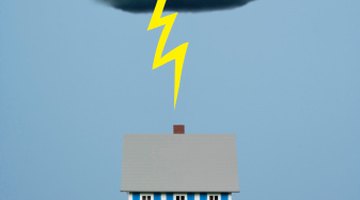How to Ground My House
Houses have grounding wires connected to outlets and fixtures, but the house itself is not grounded well to protect it against lightning strikes.

Standard residential construction usually only has a small bar, if any at all, at roof level, with a single thin grounding wire running to the surface, where it is connected to the ground. This is not enough to handle an area prone to lightning strikes. If you are in one of these areas, you should consider further grounding your home to keep electricity from running in through the wiring and frying your electronics equipment.
Things You Will Need
- Grounding rods
- Copper wire
- Staple gun or stick-on plastic wire clips
- Sledge hammer
- Shovel
- Soldering iron
- Lightning arrester
- Outlet surge protectors
-
Run copper wire starting at the main electrical panel then out of the house and into the yard. You can run it under carpet, down along the baseboard, out a window or however else you need to get it outside. Secure the wire to walls with staples or plastic clips to keep it out of the way. Run the wire out about 10 to 20 feet away from the house then wrap it once around the first grounding rod about 4 inches from one end. Rods can run anywhere from 4 feet to 10 feet long, but typically a 6- to 8-foot rod is used. These are made of either galvanized metal or copper.
-
Run the wire around the house, keeping it at least 10 feet away. Every 10 feet wrap the wire around another grounding rod and continue on with the same wire. Do this until you have circled the home.
-
Solder the copper wire to each rod with a soldering iron. Apply solder to each rod all around the wire that touches it. The wire can also be welded on.
-
Drive the rods into the ground until you are about 6 inches from the end. Use a sledge hammer. Stop when the wire is almost at ground level.
-
Dig a trench for the wire between the rods and hammer the rods down until they are flush with the ground. Fill in the trench to cover the rods.
-
Hire an electrician to connect the copper wire to the electrical panel with a lightning arrester.
-
Plug surge protectors into outlets for electrical equipment, such as televisions, stereos and computers.
The Drip Cap
- Houses have grounding wires connected to outlets and fixtures, but the house itself is not grounded well to protect it against lightning strikes.
- Run the wire out about 10 to 20 feet away from the house then wrap it once around the first grounding rod about 4 inches from one end.
- These are made of either galvanized metal or copper.
- Apply solder to each rod all around the wire that touches it.
Writer Bio
Tara Dooley has written for various websites since 2008. She has worked as an accountant, after-school director and retail manager in various locations. Dooley holds a Bachelor of Science in business management and finance.
Photo Credits
- Jupiterimages/Comstock/Getty Images
- Jupiterimages/Comstock/Getty Images
More Articles



